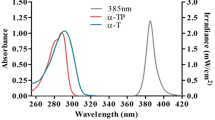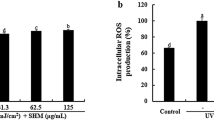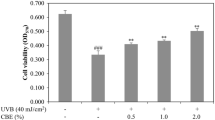Abstract
The cytoprotective effects of 6′-O-galloylpaeoniflorin against injury and death of human HaCaT keratinocytes resulting from ultraviolet B radiation were investigated. 6′-O-galloylpaeoniflorin exhibited the capacity to scavenge intracellular reactive oxygen species (ROS) generated by ultraviolet B radiation. 6′-O-galloylpaeoniflorin also attenuated ultraviolet B-induced oxidative macromolecular damage to DNA, lipids, and proteins, decreasing the number of DNA strand breaks, the level of 8-isoprostane (a biomarker of lipid peroxidation), and the level of protein carbonylation. Moreover, 6′-O-galloylpaeoniflorin rescued HaCaT cells from ultraviolet induced cell death, by downregulating the mitochondrial apoptotic pathway. Taken together, these results indicate that 6′-O-galloylpaeoniflorin has the potential to be developed as a medical agent against ROS-mediated skin diseases.








Similar content being viewed by others
References
Afaq F (2011) Natural agents: cellular and molecular mechanisms of photoprotection. Arch Biochem Biophys 508:144–151
Alfadda AA, Sallam RM (2012) Reactive oxygen species in health and disease. J Biomed Biotechnol. doi:10.1155/2012/936486; 2012
Beauchamp MC, Letendre É, Renier G (2002) Macrophage lipoprotein lipase expression is increased in patients with heterozygous familial hypercholesterolemia. J Lipid Res 43:215–222
Carmichael J, DeGraff WG, Gazdar AF, Minna JD, Mitchell JB (1987) Evaluation of a tetrazolium-based semiautomated colorimetric assay: assessment of chemosensitivity testing. Cancer Res 47:936–942
Chang H, Sander CS, Müller CS, Elsner P, Thiele JJ (2002) Detection of poly (ADP-ribose) by immunocytochemistry: a sensitive new method for the early identification of UVB-and H2O2-induced apoptosis in keratinocytes. Biol Chem 383:703–708
Dalle-Donne I, Rossi R, Giustarini D, Milzani A, Colombo R (2003) Protein carbonyl groups as biomarkers of oxidative stress. Clin Chim Acta 329:23–38
de Gruijl FR, van Kranen HJ, Mullenders LH (2001) UV-induced DNA damage, repair, mutations and oncogenic pathways in skin cancer. J Photochem Photobiol B 63:19–27
F’guyer S, Afaq F, Mukhtar H (2003) Photochemoprevention of skin cancer by botanical agents. Photodermatol Photoimmunol Photomed 19:56–72
Grewe M, Gyufko K, Krutmann J (1995) Interleukin-10 production by cultured human keratinocytes: regulation by ultraviolet B and ultraviolet A1 radiation. J Invest Dermatol 104:3–6
Hampton MB, Orrenius S (1998) Redox regulation of apoptotic cell death. Bio Factors 8:1–5
Hyun YJ, Piao MJ, Zhang R, Choi YH, Chae S, Hyun JW (2012) Photo-protection by 3-bromo-4, 5-dihydroxybenzaldehyde against ultraviolet B-induced oxidative stress in human keratinocytes. Ecotoxicol Environ Saf 83:71–78
Ichihashi M, Ueda M, Budiyanto A, Bito T, Oka M, Fukunaga M, Tsuru K, Horikawa T (2003) UV-induced skin damage. Toxicology 189:21–39
Ikehata H, Ono T (2011) The mechanisms of UV mutagenesis. J Radiat Res 52:115–125
Jeong SY, Seol DW (2008) The role of mitochondria in apoptosis. BMB Rep 41:11–22
Kang SS, Shin KH, Chi HJ (1991) Galloylpaeoniflorin, a new acylated monoterpene glucoside from paeony root. Arch Pharmacal Res 14:52–54
Liu S, Guo C, Wu D, Ren Y, Sun MZ, Xu P (2012) Protein indicators for HaCaT cell damage induced by UVB irradiation. J Photochem Photobiol B 114:94–101
Matsuda H, Ohta T, Kawaguchi A, Yoshikawa M (2001) Bioactive constituents of Chinese natural medicines. VI. Moutan cortex. (2): structures and radical scavenging effects of suffruticosides A, B, C, D, and E and galloyl-oxypaeoniflorin. Chem Pharm Bull 49:69–72
Mohamad N, Gutiérrez A, Núñez M, Cocca C, Martín G, Cricco G, Medina V, Rivera E, Bergoc R (2005) Mitochondrial apoptotic pathways. Biocell 29:149–161
Nicoletti I, Migliorati G, Pagliacci MC, Grignani F, Riccardi C (1991) A rapid and simple method for measuring thymocyte apoptosis by propidium iodide staining and flow cytometry. J Immunol Methods 139:271–279
Nishi J, Ogura R, Sugiyama M, Hidaka T, Kohno M (1991) Involvement of active oxygen in lipid peroxide radical reaction of epidermal homogenate following ultraviolet light exposure. J Invest Dermatol 97:115–119
Okimoto Y, Watanabe A, Niki E, Yamashita T, Noguchi N (2000) A novel fluorescent probe diphenyl-1-pyrenylphosphine to follow lipid peroxidation in cell membranes. FEBS Lett 474:137–140
Punnonen K, Puntala A, Ahotupa M (1991) Effects of ultraviolet A and B irradiation on lipid peroxidation and activity of the antioxidant enzymes in keratinocytes in culture. Photodermatol Photoimmunol Photomed 8:3–6
Rajagopalan R, Ranjan SK, Nair CKK (2003) Effect of vinblastine sulfate on γ-radiation-induced DNA single-strand breaks in murine tissues. Mutat Res Genet Toxicol Environ Mutag 536:15–25
Ravanat JL, Douki T, Cadet J (2001) Direct and indirect effects of UV radiation on DNA and its components. J Photochem Photobiol B 63:88–102
Ray PD, Huang BW, Tsuji Y (2012) Reactive oxygen species (ROS) homeostasis and redox regulation in cellular signaling. Cell Signal 24:981–990
Rosenkranz AR, Schmaldienst S, Stuhlmeier KM, Chen W, Knapp W, Zlabinger GJ (1992) A microplate assay for the detection of oxidative products using 2’,7’-dichlorofluorescin-diacetate. J Immunol Methods 156:39–45
Sander CS, Chang H, Hamm F, Elsner P, Thiele JJ (2004) Role of oxidative stress and the antioxidant network in cutaneous carcinogenesis. Int J Dermatol 43:326–335
Sander CS, Chang H, Salzmann S, Müller CS, Ekanayake-Mudiyanselage S, Elsner P, Thiele JJ (2002) Photoaging is associated with protein oxidation in human skin in vivo. J Invest Dermatol 118:618–625
Savini I, D’Angelo I, Ranalli M, Melino G, Avigliano L (1999) Ascorbic acid maintenance in HaCaT prevents radical formation and apoptosis by UV-B. Free Radical Biol Med 26:1172–1180
Scandalios JG (2002) The rise of ROS. Trends Biochem Sci 27:483–486
Schwarz A, Bhardwaj R, Aragane Y, Mahnke K, Riemann H, Metze D, Luger TA, Schwarz T (1995) Ultraviolet-B-induced apoptosis of keratinocytes: evidence for partial involvement of tumor necrosis factor-α in the formation of sunburn cells. J Invest Dermatol 104:922–927
Singh NP (2000) Microgels for estimation of DNA strand breaks, DNA protein crosslinks and apoptosis. Mutat Res Fundam Mol Mech Mutag 455:111–127
Stahl W, Sies H (2002) Carotenoids and protection against solar UV radiation. Skin Pharmacol Physiol 15:291–296
Tsujimoto Y, Shimizu S (2000) Bcl-2 family: life-or-death switch. FEBS Lett 466:6–10
Washida K, Itoh Y, Iwashita T, Nomoto K (2009) Androgen modulators from the roots of Paeonia lactiflora (Paeoniae Radix) grown and processed in nara prefecture. Japan Chem Pharm Bull 57:971–974
Wyllie A, Morris R, Smith A, Dunlop D (1984) Chromatin cleavage in apoptosis: association with condensed chromatin morphology and dependence on macromolecular synthesis. J Pathol 142:67–77
Yao CW, Piao MJ, Kim KC, Zheng J, Cha JW, Hyun JW (2013) 6’-O-Galloylpaeoniflorin protects human keratinocytes against oxidative stress-induced cell damage. Biomol Ther 21:349–357
Acknowledgment
This research was supported by the 2014 scientific promotion program funded by Jeju National University.
Author information
Authors and Affiliations
Corresponding author
Additional information
Editor: T. Okamoto
Rights and permissions
About this article
Cite this article
Yao, C.W., Piao, M.J., Kim, K.C. et al. Cytoprotective effects of 6′-O-galloylpaeoniflorin against ultraviolet B radiation-induced cell damage in human keratinocytes. In Vitro Cell.Dev.Biol.-Animal 50, 664–674 (2014). https://doi.org/10.1007/s11626-014-9747-0
Received:
Accepted:
Published:
Issue Date:
DOI: https://doi.org/10.1007/s11626-014-9747-0




